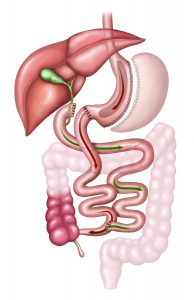 Knowing that bariatric surgery may not yield the desired amount of weight loss and that complications may not be amenable to non-surgical management, available surgical options for revision should be part of the counseling before choosing any bariatric surgery.
Knowing that bariatric surgery may not yield the desired amount of weight loss and that complications may not be amenable to non-surgical management, available surgical options for revision should be part of the counseling before choosing any bariatric surgery.
Being a reversible and relatively safe procedure with little or no anatomical alteration of the digestive tract, gastric banding has enjoyed popularity among obese people looking for a reversible and less complicated bariatric surgery. However, when compared to other weight loss surgeries such as gastric sleeve or gastric bypass, it has lower weight loss potentials.
In gastric banding, the stomach size is reduced with the use of an adjustable silicone band. This band is placed around the stomach while the tube extends to an area just beneath the skin. The silicone is then inflated with sterile water the quantity of which can be adjusted. The part of the stomach above the band serves as the reservoir for food and due to its small size gets full easily leading to satiety. The lower portion only serves as a conduit to convey the partially digested food from the upper pouch into the small intestine.
Looking at the above configuration, the primary mechanism of weight loss is a reduction in stomach size. The production of appetite hormone ghrelin is not reduced as the whole stomach is still intact. While these patients may have a healthy appetite, the early satiety prevents them from eating excessively. Thus, ability to obey this initial satiety feeling determines the weight loss outcome.
The expected weight loss after gastric banding is about 50% of the excess weight and almost 50% of those that had gastric banding will not achieve this level of weight loss. Inadequate weight loss is said to be the most common reason for revision surgery after gastric banding.1 It is, however, essential to know that insufficient weight loss may be due to dietary problems which should be addressed before revision procedure.
Other reasons for gastric band removal and possible revision surgery include complications such as slippage, erosion, heartburn, difficulty with swallowing, infection of the band and intolerance. Some of these complications may occur due to poor surgical techniques.
Band removal and revision surgery can be done simultaneously or at different times depending on the reason for removal and ability of the patient to withstand the combined procedure. For instance, if the band is removed as a result of complications, it is advisable to allow for recovery and schedule the revision surgery for another day.
Many options are available namely re-banding, gastric sleeve, gastric bypass, and duodenal switch. Gastric sleeve is the most favored revision surgery after a failed gastric banding. It is restrictive (like gastric banding) and relatively safe when compared to other revision options.
Conversion to gastric sleeve
Gastric sleeve surgery is a restrictive weight loss procedure where the stomach is reduced to 10-20% of its average size. The small intestine is left unaltered for proper digestion and absorption. Reduction in food intake and decreased appetite (due to the removal of the ‘ghrelin’ producing a portion of the stomach) are the two primary mechanisms behind weight loss seen in gastric sleeve surgery. This is a step ahead of gastric banding where appetite is not reduced.
More than 60% of the excess weight loss is expected after gastric sleeve surgery. Moon et al. conducted gastric sleeve surgery for patients with failed gastric banding. The average percentage excess weight loss was 47.7% and 65.6% after 12 and 24months respectively.
One of the major demerits is that it is often associated with the development of/worsening of an existing gastro-esophageal reflux (heartburn). Thus, patients who want their bands removed due to symptoms of heartburn are advised to go for gastric bypass surgery as it has been shown to ameliorate these symptoms. Those that still prefer gastric sleeve to gastric bypass can undergo hiatal hernia repair to address the symptoms of heartburn.
Overall, gastric sleeve surgery is a revision option available to those with failed gastric banding. It is purely restrictive with no alteration of the internal anatomy and thus no risk of any severe nutritional deficiencies. Heartburn may be a complication, but this can be treated with medications or hiatal hernia repair.
Reference
- DeMaria EJ, Sugerman HJ, Meador JG et al. High Failure Rate after Laparoscopic Adjustable Silicone Gastric Banding for Treatment of Morbid Obesity. Annals of Surgery. 2001;33(6), 809-818. doi:10.1097/00000658-200106000-00011
- Moon RC, Teixeira AF, Jawad MA. Conversion of failed laparoscopic adjustable gastric banding: Sleeve gastrectomy or Roux-en-Y gastric bypass? Surgery for Obesity and Related Diseases. 2013;9(6), 901-907. doi:10.1016/j.soard.2013.04.003



